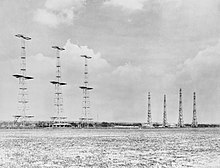 Chain Home at RAF Poling, West Sussex | |
| Country of origin | United Kingdom |
|---|---|
| Manufacturer | Metropolitan-Vickers, AC Cossor |
| Designer | AMES |
| Introduced | 1938 |
| Type | Early warning |
| Frequency | Between 20 and 55 MHz |
| PRF | 25 pps |
| Beamwidth | 150º |
| Pulsewidth | 6 to 25 µs |
| Range | 160 km (99 mi) |
| Azimuth | 150º |
| Elevation | 2.5 to 40º |
| Precision | 8 km (5.0 mi) or better (1 kilometre (0.62 mi) typical) in range, ±12º in azimuth (typically less) |
| Power | 100 kW to 1 MW depending on version |
| Other Names | RDF, RDF1, AMES Type 1, AMES Type 9 |
Chain Home, or CH for short, was the codename for the ring of coastal early warning radar stations built by the Royal Air Force (RAF) before and during the Second World War to detect and track aircraft.[1] Initially known as RDF, and given the official name Air Ministry Experimental Station Type 1 (AMES Type 1) in 1940, the radar units were also known as Chain Home for most of their life. Chain Home was the first early warning radar network in the world and the first military radar system to reach operational status.[2] Its effect on the war made it one of the most powerful systems of what became known as the "Wizard War".[3][4]
In late 1934, the Tizard Committee asked radio expert Robert Watson-Watt to comment on the repeated claims of radio death rays and reports suggesting Germany had built some sort of radio weapon. His assistant, Arnold Wilkins, demonstrated that a death ray was impossible but suggested radio could be used for long-range detection. In February 1935, a successful demonstration was arranged by placing a receiver near a BBC short wave transmitter and flying an aircraft around the area. Using commercial short wave radio hardware, Watt's team built a prototype pulsed transmitter and by June 1935 it detected an aircraft that happened to be flying past. Basic development was completed by the end of the year, with detection ranges on the order of 100 mi (160 km).
In 1936 attention was focused on a production version, and early 1937 saw the addition of height finding. The first five stations, covering the approaches to London, were installed by 1937 and began full-time operation in 1938. Over the next two years, additional stations were built while the problem of disseminating the information to the fighter aircraft led to the first integrated ground-controlled interception network, the Dowding system.[a] By the time the war started, most of the east and south coasts had radar coverage.
Chain Home proved important during the Battle of Britain in 1940. CH systems could detect enemy aircraft while they were forming over France, giving RAF commanders ample time to marshal their aircraft in the path of the raid. This had the effect of multiplying the effectiveness of the RAF to the point that it was as if they had three times as many fighters, allowing them to defeat frequently larger German forces. The Chain Home network was continually expanded, with over 40 stations operational by the war's end, including mobile versions for use overseas. Late in the war, when the threat of Luftwaffe bombing had ended, the CH systems were used to detect V2 missile launches. UK radar systems were wound down after the war but the start of the Cold War led to the Chain Home radars being pressed into service in the new ROTOR system until replaced by newer systems in the 1950s. Only a few of the original sites remain.
- ^ "The prototype CH system – 1939… Chain, Home… Operational". Bournemouth University. 1995–2009. Retrieved 23 August 2009.
- ^ Neale 1985, p. 73.
- ^ Connor, Roger (5 June 2014). "D-Day and the Wizard War". National Air and Space Museum.
- ^ Jones 1978.
Cite error: There are <ref group=lower-alpha> tags or {{efn}} templates on this page, but the references will not show without a {{reflist|group=lower-alpha}} template or {{notelist}} template (see the help page).